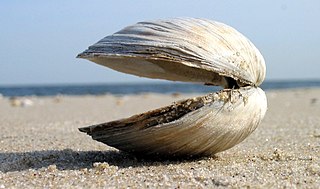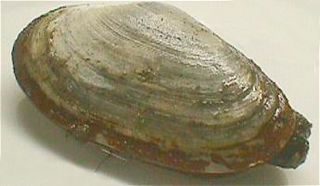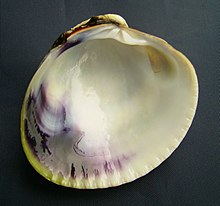
Clam is a common name for several kinds of bivalve mollusc. The word is often applied only to those that are edible and live as infauna, spending most of their lives halfway buried in the sand of the sea floor or riverbeds. Clams have two shells of equal size connected by two adductor muscles and have a powerful burrowing foot. They live in both freshwater and marine environments; in salt water they prefer to burrow down into the mud and the turbidity of the water required varies with species and location; the greatest diversity of these is in North America.

The dog whelk, dogwhelk, or Atlantic dogwinkle is a species of predatory sea snail, a carnivorous marine gastropod in the family Muricidae, the rock snails.

A tide pool or rock pool is a shallow pool of seawater that forms on the rocky intertidal shore. These pools typically range from a few inches to a few feet deep and a few feet across. Many of these pools exist as separate bodies of water only at low tide, as seawater gets trapped when the tide recedes. Tides are caused by the gravitational pull of the sun and moon. A tidal cycle is usually about 25 hours and consists of two high tides and two low tides.

Kaipara Harbour is a large enclosed harbour estuary complex on the north western side of the North Island of New Zealand. The northern part of the harbour is administered by the Kaipara District and the southern part is administered by the Auckland Council. The local Māori tribe is Ngāti Whātua.

The brown teal is a species of dabbling duck of the genus Anas native to New Zealand. For many years it had been considered to be conspecific with the flightless Auckland and Campbell teals in Anas aucklandica; the name "brown teal" has also been largely applied to that entire taxon. Common in the early years of European colonisation, the "brown duck" was heavily harvested as a food source. Its numbers quickly fell, especially in the South Island, and in 1921 they became fully protected. Captive breeding and releasing into predator-controlled areas has seen good localised populations re-introduced around the country in recent years.

The American oystercatcher, occasionally called the American pied oystercatcher, is a member of family Haematopodidae. Originally called the "sea pie", it was renamed in 1731 when naturalist Mark Catesby claimed that he had observed the bird eating oysters. The current population of American oystercatchers is estimated to be 43,000. There are estimated to be 1,500 breeding pairs along the Atlantic and Gulf Coasts of the US. The bird is marked by its black and white body and a long, thick orange beak.

Soft-shell clams or Sand gaper, scientific name Mya arenaria, popularly called "steamers", "softshells", "piss clams", "Ipswich clams", or "Essex clams", are a species of edible saltwater clam, a marine bivalve mollusk in the family Myidae.

Intertidal ecology is the study of intertidal ecosystems, where organisms live between the low and high tide lines. At low tide, the intertidal is exposed whereas at high tide, the intertidal is underwater. Intertidal ecologists therefore study the interactions between intertidal organisms and their environment, as well as between different species of intertidal organisms within a particular intertidal community. The most important environmental and species interactions may vary based on the type of intertidal community being studied, the broadest of classifications being based on substrates—rocky shore and soft bottom communities.

Amphibola crenata is a species of air-breathing snail with an operculum, a pulmonate gastropod mollusc which lives in a habitat that is intermediate between the land and the sea, not entirely terrestrial and not entirely marine. This is not a true land snail, but it is also not a true sea snail. Unlike almost all other snails that have opercula, this species breathes air. It is common in New Zealand.

The Atlantic jackknife clam, Ensis leei, also known as the bamboo clam, American jackknife clam or razor clam, is a large edible marine bivalve mollusc found on the North American Atlantic coast, from Canada to South Carolina. The species was also introduced to Europe at the end of the 70's and is already extremely abundant there in suitable habitats. The name "razor clam" is also used to refer to different species such as the Pacific razor clam or Razor shell.

A rocky shore is an intertidal area of seacoasts where solid rock predominates. Rocky shores are biologically rich environments, and are a useful "natural laboratory" for studying intertidal ecology and other biological processes. Due to their high accessibility, they have been well studied for a long time and their species are well known.

The South Island oystercatcher or South Island pied oystercatcher is one of two common oystercatcher species found in New Zealand. Its name is often contracted to the acronym "SIPO". The indigenous Māori name is tōrea. The scientific name commemorates the German ethnographer, naturalist and colonial explorer Friedrich Hermann Otto Finsch.

The common cockle is a species of edible saltwater clam, a marine bivalve mollusc in the family Cardiidae, the cockles. It is found in waters off Europe, from Iceland in the north, south into waters off western Africa as far south as Senegal. The ribbed oval shells can reach 6 centimetres (2.4 in) across and are white, yellowish or brown in colour. The common cockle is harvested commercially and eaten in much of its range.

Ōmana Regional Park is situated south-east of Auckland and just west of Maraetai, in the Franklin area of the Auckland Region of New Zealand's North Island. It is owned and managed by Auckland Council.

Tucetona laticostata, or the large dog cockle, is a salt water clam or marine bivalve mollusc in the family Glycymerididae.
This page is a list of fishing topics.

Austrovenus is a genus of marine bivalve molluscs, in the family Veneridae. This genus is native to New Zealand.

Pisaster brevispinus, commonly called the pink sea star, giant pink sea star, or short-spined sea star, is a species of sea star in the northeast Pacific Ocean. It was first described to science by William Stimson in 1857. The type specimen was collected on a sandy bottom, 10 fathoms (18 m) deep, near the mouth of San Francisco Bay.

Te Matuku Marine Reserve is a marine reserve administered by the New Zealand Department of Conservation. It includes Te Matuku Bay, one of the largest and least disturbed estuaries on Waiheke Island, as well as a surrounding area of sea. It covers an area of 690 ha and was established in 2003.

Kiwi Esplanade is a coastal street in Māngere Bridge, Auckland, New Zealand, following the shore of the Manukau Harbour. A public walkway connects Ngā Hau Māngere Bridge in the east to Ambury Regional Park in the west. The shoreline is notable for the visible pāhoehoe lava flows, which originated from Māngere Mountain.




















